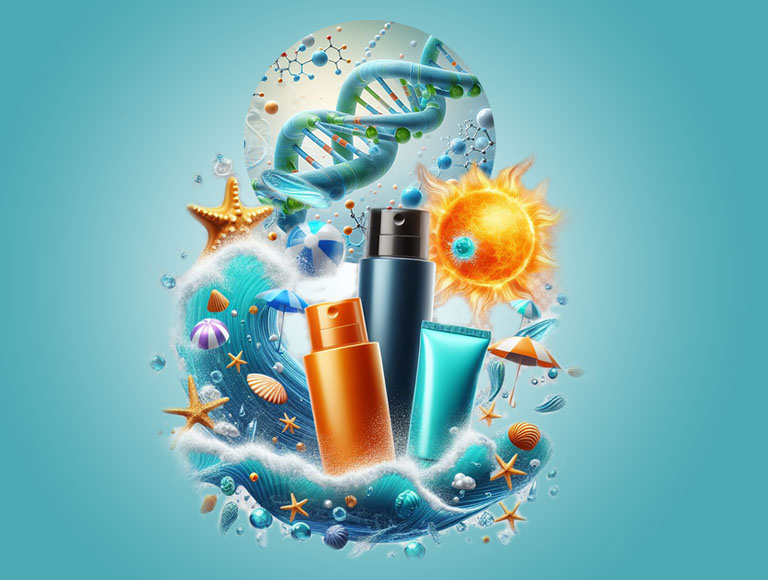
The use of sunscreens is crucial for protecting the skin against damage caused by the sun's ultraviolet (UV) rays. However, recent research has raised concerns about the possible effects on the development of children and adolescents of some ingredients present in sunscreens, especially chemical ones.
What are Endocrine Disruptors?
Endocrine disruptors are chemicals that can interfere with the body's hormonal system, mimicking or blocking natural hormones. This interference can lead to a number of health problems, including:
- Reproductive problems: infertility, abnormal development of genitals, early or late puberty
- Cancer: increased risk of breast, prostate, thyroid and other cancers
- Neurological problems: learning, memory and mood disorders
- Metabolic problems: obesity, diabetes and heart disease
Currently (April 2022) no compounds are identified/regulated for endocrine disrupting properties under the Cosmetic Products Regulation, although the Commission is carrying out a targeted literature screening of selected compounds.
Sunscreens and Endocrine Disruption
Some of the ingredients commonly used in sunscreens, such as:
- Oxybenzone: or benzophenone-3 (BP-3), in February 2019, the FDA considered BP-3 in Category III: Unsafe for use as a UV filter. The FDA considered that data on the reproductive and developmental toxicity of BP-3 have been reported. The European chemicals organization ECHA REACH places BP-3 on list I and classifies it as an endocrine disruptor;
https://health.ec.europa.eu/publications/benzophenone-3_en
https://edlists.org/the-ed-lists
- Homosalate: an endocrine disruptor that can imitate estrogen and interfere with thyroid function, in addition to decreasing fertility. The European organization on chemical substances ECHA REACH places homosalate on list I and classifies it as an endocrine disruptor;
- Avobenzone: a possible endocrine disruptor that can interfere with thyroid function is part of ECHA REACH list II and is under investigation.
- Ethylhexyl salicylate: or octisalate, can be an endocrine disruptor and can interfere with thyroid function and testosterone production. However, it is not on any ECHA REACH list and is not under investigation.
- Octocrylene: can interfere with thyroid function, increasing the size of the gland, and testosterone production. It is part of list I of the European ECHA regulation, confirming that it is an endocrine disruptor, despite being permitted to be used in cosmetics.
What to do?
Although research into endocrine disruptors in sunscreens is still ongoing, it is important to take some precautions:
- Choose mineral sunscreens: Mineral sunscreens, such as titanium dioxide and zinc oxide, are considered safer than chemical sunscreens and do not pose the same risks of endocrine disruption.
- Avoid sunscreens that contain oxybenzone (benzophenone-3), Octocrylene, homosalate and avobenzone.
SF can help your company develop Sunscreens with safe ingredients that do not affect people's health and carry out safety assessments.
How important is the Security Assessment?
- The combination of safety assessment and testing is essential to ensure the safety and quality of cosmetic products.
- Companies must stay up to date with best practices and regulations to ensure product safety and consumer trust.
- Ensuring the safety of cosmetic products is fundamental to consumer reputation and trust.
- Investing in security assessment and testing can prevent legal and financial problems arising from unsafe products.
Want to know more about Security Assessment?
- Visit our website: https://sfsafetyconsulting.com.br/
- Follow our social media pages on Facebook and Instagram.
Safety in cosmetics. Because you need to have it.
SF Safety Consulting.
Passion for knowledge and science.
Important:
Research into endocrine disruptors in sunscreens is still ongoing and the results may be uncertain. However, it is always best to take precautions to protect your health.
There are several online resources that can help you find sunscreens that are safe and free of endocrine-disrupting ingredients. Some examples include the Environmental Working Group (https://www.ewg.org/sunscreen/) and the Think Healthy Foundation (https://mentalhealthfoundation.org/category/healthy-thinking/).
